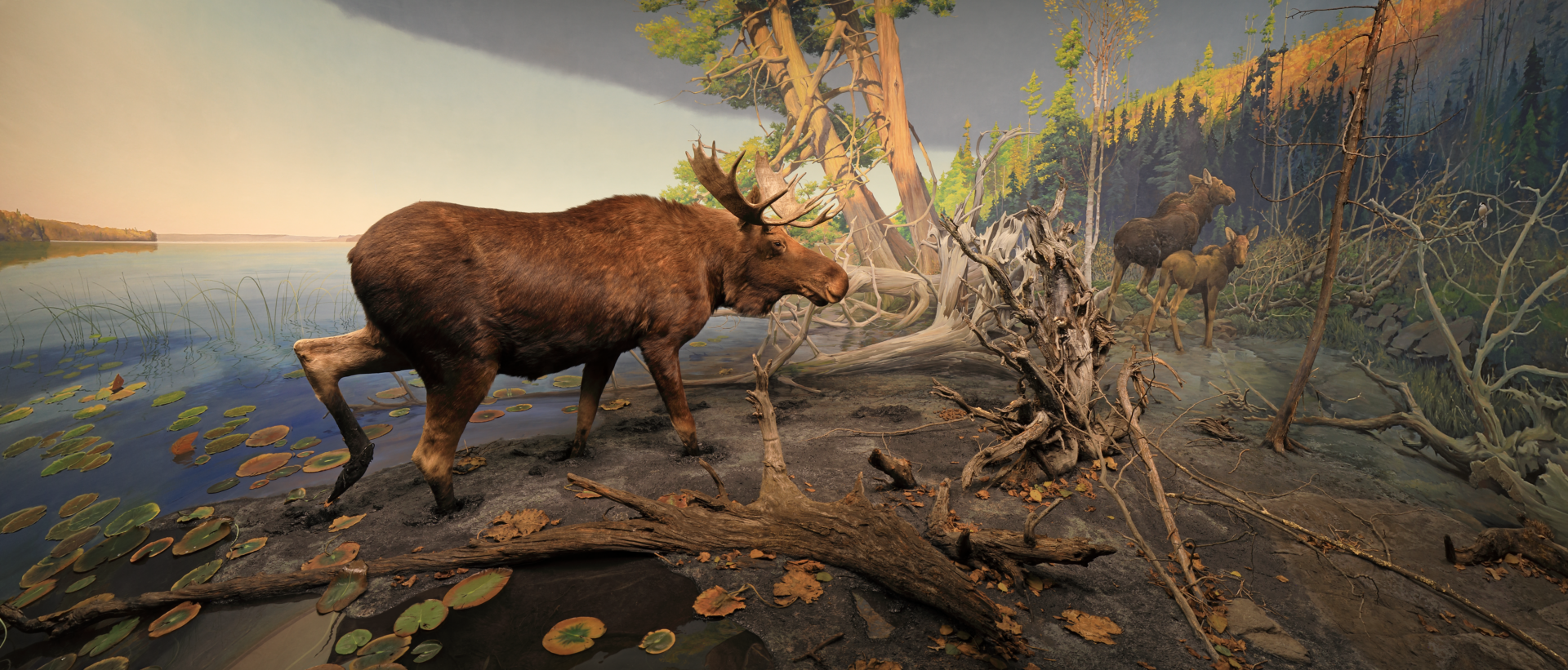
Diorama Spotlight: Moose at Gunflint Lake
Published06/13/2020 , by Amber Kastner, Public Science Events Manager
In northern Minnesota, where the southern hardwood trees give way to the boreal forests of Canada, a unique transition area provides habitat for some of our state’s most iconic species. Along the border in particular, the Boundary Waters Canoe Area Wilderness protects many of these plants and animals from development and provides guidance for managing them. The boundary waters span more than a million acres of forest and connect a thousand lakes, providing abundant resources for moose, bear, wolves, beavers, bobcats, loons, and many others. Gunflint Lake sits on the edge of this protected area and is the scene for the moose diorama at the Bell Museum. It is here, at the Gunflint Lodge in 1943, that Francis Lee Jaques began to study and collect materials for its creation.
Moose are generally solitary creatures, and the scene depicted within the diorama provides several clues that we are observing an autumn day. Rather than standing alone, the bull moose follows a cow and calf as they head toward a forest of changing trees in the distance covered with golden aspen and birch leaves. Their proximity tells us it is late September, and the bull moose has shifted his focus away from eating and towards mating. It is possible that he has interrupted the cow and calf as they gather aquatic plants to store energy for the winter. The calf was born in the spring and will stay with its mother through the coming colder months.

Artist Francis Lee Jaques painting the moose backdrop in the 1940s
As the moose travels through this wetland, we begin to notice the abundance of this environment and the moose’s place within it. The perimeter of the lake is covered with water and pond lilies, and the moose will use its sensitive snout to collect these plants from under the surface. Deciduous trees such as aspen, willow, and birch are found throughout the landscape, where the moose can graze on them frequently. A vast forest of coniferous spruce and balsam fir lie just beyond water’s edge and provide a consistent winter food source. This is important for the 1,000 pound moose, who will consume more than 30 pounds of plants a day. The shoreline is also punctuated with fallen northern white cedars and deep mud. And while it would seem impossible to traverse this ground, it is an easy task for the moose. His long legs help him move through mud, water, snow, and around fallen trees with agility.

The moose is positioned to demonstrate the animal’s ability to wander through muddy wetland environments.
In recent years, moose populations in Minnesota have been a matter of some concern. After a large decrease in numbers between 2009 and 2012, scientists and researchers set out to determine what was causing the change in population. A variety of factors including parasitic brainworm brought in by encroaching deer populations, increased predation from wolves and bears, and the effects of climate change leading to extended tick seasons and changes for summer feeding have all had an impact and lead to fewer overall numbers of moose. Research to protect these moose continues, and there is good news in aerial surveys that show a steady population of the animals in Minnesota for the past eight years. If you would like to learn more about the challenges facing moose in our state, please explore research from the University of Minnesota College of Veterinary Medicine https://profiles-vetmed.umn.edu/article/fight-minnesotas-moose and the Minnesota Department of Natural Resources https://www.dnr.state.mn.us/moose/index.html.
Moose at Gunflint Lake
Location: Gunflint Lake in the Boundary Waters Canoe Area Wilderness, Cook County, Minnesota
Biome: Northern Forest
Season: Late September
Date completed: 1946 (painted in 1944)
Dimensions: 10’x 22’
Background Artist: Francis Lee Jaques
Foreground Artist: Walter J. Breckenridge
Restoration 2017: Midwest Art Conservation Center, Chase Studios, Museum Professionals, and Split Rock Studios
Donors: James Ford Bell – founding donor, Diorama Legacy Society – restoration donor







